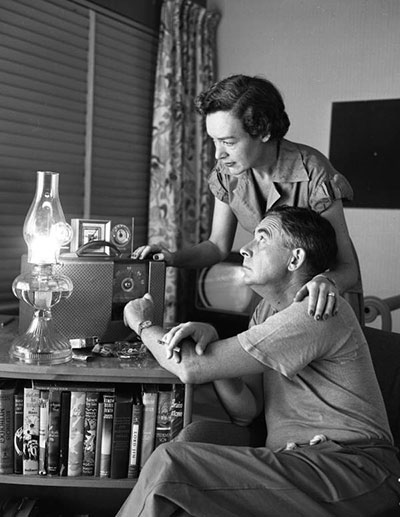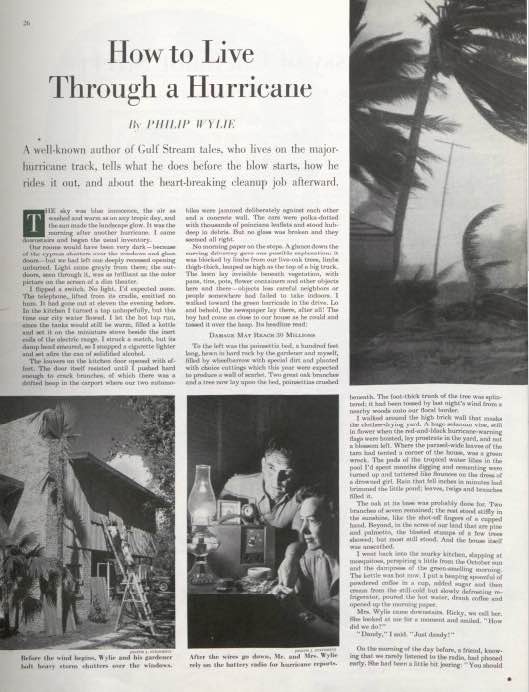The annals of history overflow with the overlooked. Some people were incredibly famous in their time, but have faded from view even as their influence abides. Philip Wylie might be one such person. A prolific writer of novels, nonfiction, screenplays, essays, and articles (many of which were for The Saturday Evening Post), Wylie may be most famous for his 1943 book, Generation of Vipers, which essentially attacked every American institution from religion to government to mothers. In genre fiction circles, he’s most well-known and remembered for his novels like Gladiator, The Savage Gentleman, and When Worlds Collide. Those books left an indelible mark in their field and planted seeds that would become the avatar of America’s popular mythology: the super-hero.
Wylie’s life as a writer is hard to categorize. His work covered a broad area, touching many disciplines and topics. Whereas some working writers find their genre and stick to it (with occasional divergences into other styles), Wylie wrote just about everything. Born in 1902 to a minister father and a writing mother who died when he was five, Wylie had a keen interest in science and philosophy as well as literature.
The interest in science would be applied regularly to his writing, particularly, and unsurprisingly, to his science fiction work. His first two novels, Heavy Laden (1928) and Babes and Sucklings (1929), were both described as comedies of manners, with the first leaning heavily on details from his own life (one of the main characters has a minister father). 1930’s Gladiator leaned all the way into the science fiction genre. The main character is Hugo Danner, a man who is born with enhanced strength, speed, and invulnerability after his scientist father injects his pregnant mother with an experimental serum. Danner uses his strength for money-making endeavors, but eventually joins the French Foreign Legion to fight against Germany in World War I. The book has stayed in print over the decades; Marvel Comics adaptated the first half of the novel in Marvel Preview #9 in 1976, with legendary comics writer Roy Thomas handling the writing duties.
Roy Thomas’s manager, John Cimino, arranged for the venerable writer to discuss Wylie and why Thomas wanted to adapt the story. Thomas says, “The fact that it was such a seminal influence, I felt, on the concept of the super-hero… even though it in turn was probably influenced by the likes Edgar Rice Burroughs’ John Carter of Mars novels and John Campbell’s story/novel The Mightiest Machine… made me want to adapt it at Marvel, even though I only got the chance to adapt the first half of it before I left Marvel for a time in 1980.”
On the broader subject of Hugo Danner as an influence on Superman, who didn’t appear in Action Comics #1 until 1938, Thomas says, “I know that [Superman co-creator] Jerry Siegel never admitted to a direct inspiration from Gladiator, but I have always pretty much discounted that as being said for legal reasons. After all, Jerry was a prominent and wide-reading SF fan in the 1920s and ’30s.” Thomas went on to say that some occurances in the novel were very similar to scenes from the novel, with both seeing the leads avenging wrongs and pushing back against bad businesspeople.Thomas says, “I can accept the general idea that the similarities may have been a coincidence, but I find it impossible to believe myself.”
Thomas would later get the chance to take advantage of Gladiator’s public domain status and incorporate Hugo Danner into his Young All-Stars comic at DC in the 1980s. One of the lead characters was young super-strongman Iron Munro, and Thomas canonized Hugo Danner as Munro’s father. Thomas says, “I knew that Arn Munro had been the super-human hero of Campbell’s novel/story The Mightiest Machine in Astounding Stories . . . an Earthman raised on Jupiter and thus gaining great strength and leaping abilities when he returned to his native Earth… Clearly, here was another possible inspiration for Superman, though it came later than Gladiator… so I decided that Arn Munro should be the son of Hugo Danner.”

Thomas pretty clearly sets a line of lineage from early science fiction novels through Gladiator and onward to Superman. But Gladiator wasn’t Wylie’s only novel to have a huge impact on comic and pulp heroes. His 1932 novel, The Savage Gentleman, sports more than a few similarities to a hero that would debut a year later in his self-titled magazine, Doc Savage. In The Savage Gentleman, Henry Stone is raised on an island by his father and two of his father’s servants and returns to a 1930s New York an incredible physical specimen with a fortune waiting for him; his hair is even described as “bronze.” Doc Savage, nicknamed “The Man of Bronze,” was an Olympic-level athlete and an expert at everything after being trained by men chosen by his father. As Thomas says, “[I]t was amusing to learn later that Wylie had also written a book titled The Savage Gentleman, who some see as influential on Doc Savage… who in turn was called a ‘Superman’ in ads before DC’s comic hero emerged… and was known as ‘the Man of Bronze,’ where Superman became first the ‘Man of Tomorrow,’ but soon the ‘Man of Steel.’”
In 1933, Wylie turned his attention to the stars for one of his best-remembered novels, When Worlds Collide. The story, co-written with Edwin Balmer, deals with a scientist discovering that two rogue planets may destroy Earth and the steps taken to try to save the population. As explained in the 1990 book, Flash Gordon: Mongo, the Planet of Doom, the novel was a direct influence on Alex Raymond, who took central plot elements of Wylie’s and created and drew the newspaper comic strip Flash Gordon the following year. The lineage of When Worlds Collide resonates through many branches of pop culture, as George Lucas has repeatedly identified Flash Gordon as an immediate influence on Star Wars.
The trailer for When Worlds Collide (Uploaded to YouTube by YouTube Movies)
Wylie’s work in those three novels formed the foundation for thousands of super-hero characters that come after them. Hugo Danner is the science fiction super-human, like Superman. Henry Stone is the pulp hero, a product of training backed by wealth, like Doc Savage and, later, Batman (who himself owes debts to Zorro and the Scarlet Pimpernel). The leads of Collide are the space heroes, like Flash Gordon, the Hal Jordan Green Lantern, and the Fantastic Four. Those are the starting points for a remarkable number of characters that would follow in four-color comics just a few years later.
As he worked on those novels, Wylie also worked in Hollywood, writing the screenplay for the adaptation of H.G. Wells’s The Island of Dr. Moreau, 1932’s The Island of Lost Souls. He also did uncredited work on the 1933 film version of Wells’s The Invisible Man, which borrowed as much from Wylie’s own novel, 1931’s The Murderer Invisible, as it did from Wells. He also had various other novels adapted into film, like 1949’s Night Unto Night, starring Ronald Reagan.
Over the following years, Wylie would continue to write, well, everything. A past director of the Lerner Marine Laboratory, he wrote dozens of short stories about fishermen Crunch and Des, many of which ran in The Saturday Evening Post, and were packaged in eight collections over time; the stories became a short-lived TV series in the 1950s. The first and most famous of his nonfiction books, Generation of Vipers, landed in 1942, and was (and is) controversial. Amid his attacks on Christianity and Washington, D.C., Wylie put down the lionization of the role of mothers in culture, calling it “momism.” Wylie both supported and walked back various statements from the book over the years, and critics have vacillated between calling that attitude misogynistic or taking a stance others wouldn’t. A Washington Post reassessment from 2005 notes that the book feels more like Wylie was attacking things just because they were there.
Wylie’s fiction continued to draw attention in occasionally surprising ways. His scrupulously researched writing on nuclear weapons (as in The Smuggled Atomic Bomb) was so knowledgeable and precise that he was questioned by the authorities. Ironically, that knowledge base would also earn him a place as an advisor to the Joint Congressional Committee for Atomic Energy. He also had progressive notes in his fiction. In the 1951 novel, The Disappearance, he speculates on what would happen if men and women were suddenly cosmically separated. After a “blink” splits the world into two versions, one of only men and one of only women, Wylie examines how the men-only world begins to decline while the women-only world thrives. He also manages to approach homosexuality, a huge taboo at the time, in light of what happens when there’s only one gender remaining in the world.
At The Saturday Evening Post, in addition to Crunch and Des, Wylie’s pieces covered a predictably huge range of subject matter. He wrote on student performance in college, doctors in Bimini, and surviving hurricanes, among other topics. Portions of his novel, Triumph, about the after-effects of a nuclear war, were serialized in the Post. For other outlets, he wrote about medievalism, career women, UFOs, missile defense, censorship, and the work of Mickey Spillane.
Philip Wylie died in 1971, but his work continues to resonate. His fiction shaped comic books, science fiction, film horror, and more. His nonfiction forced people to reexamine their own opinions. The majority of his work is still in print, even if it’s overlooked by the general public. Aficionados of genre fiction remember him, but the sheer breadth of his contributions isn’t always recognized. At least for now, Philip Wylie remains the unsung hero of super-heroes.

Featured image: Shutterstock
Become a Saturday Evening Post member and enjoy unlimited access. Subscribe now




Comments
The DC Comics editors and writers did pinch Doc’s arctic Fortress of Solitude.
Lot of things wrong with this. Doc Savage did not influence Superman. As you see, Hugo Danner influenced Superman ( he is Hugo Danner in a costume). Batman was influenced by Doc Savage ( he is Doc Savage in a costume).
Superman is nothing like Doc Savage, who is a wealthy scientist, surgeon, criminologist, polymath, gadgeteer, leader of a team (hm, sounds like Batman!).
A power doesn’t make one a superhero. A costume does.
Superman and Batman are both superheroes. Superman has a costume, powers, fights crime, doesn’t wear a mask and uses a sobriquet. Batman has a costume, no powers, fights crime, wears a mask and uses a sobriquet.
Doc Savage is not a superhero. He fights crime but has no costume and doesn’t not use a sobriquet. Flash Gordon is not a superhero, either. He has a costume but does not use a sobriquet and isn’t fighting crime (“Flash,” like “Doc,” is a nickname). In fact, when you cite Flash Gordon and Doc Savage as superheroes you prove my point that superheroes aren’t determined by powers.
If there is any question as to what makes a superhero, I have just given you the definitive answer. It applies to all superheroes. Fantastic 4 (Thing has a costume he refuses to wear), the Punisher (he is Mack Bolan in a costume), the Vision (a superhero can be an android, only wears a costume and he only has a sobriquet!) or villains who turn good: Hawkeye, Magneto, Banshee — fighting crime, having a costume, using a sobriquet.
Let’s stop this canard.